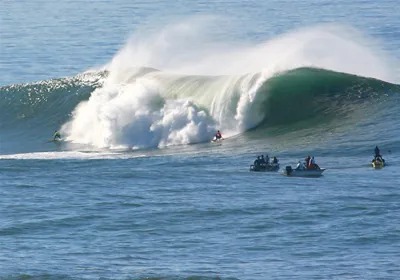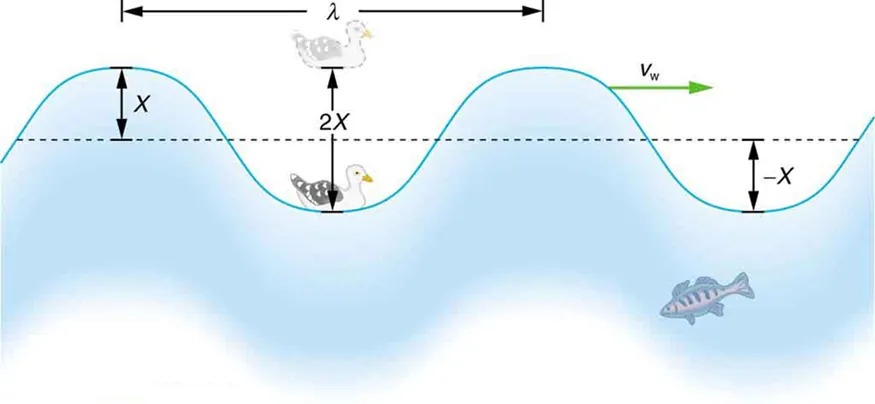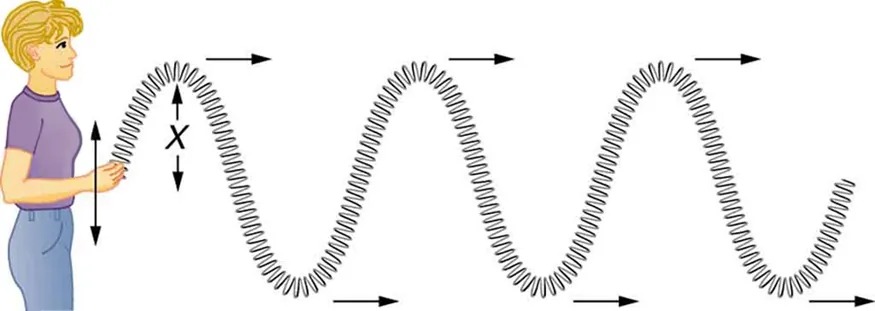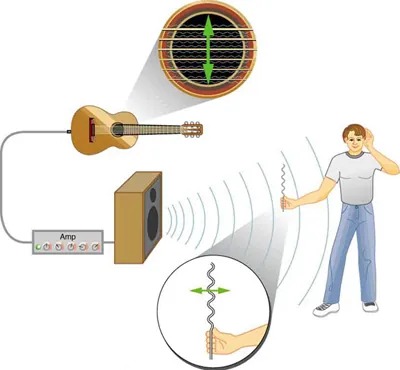13.9 Waves
Learning Objectives
By the end of this section, you will be able to:
- State the characteristics of a wave.
- Calculate the velocity of wave propagation.

What do we mean when we say something is a wave? The most intuitive and easiest wave to imagine is the familiar water wave. More precisely, a wave is a disturbance that propagates, or moves from the place it was created. For water waves, the disturbance is in the surface of the water, perhaps created by a rock thrown into a pond or by a swimmer splashing the surface repeatedly. For sound waves, the disturbance is a change in air pressure, perhaps created by the oscillating cone inside a speaker. For earthquakes, there are several types of disturbances, including disturbance of Earth’s surface and pressure disturbances under the surface. Even radio waves are most easily understood using an analogy with water waves. Visualizing water waves is useful because there is more to it than just a mental image. Water waves exhibit characteristics common to all waves, such as amplitude, period, frequency and energy. All wave characteristics can be described by a small set of underlying principles.
A wave is a disturbance that propagates, or moves from the place it was created. The simplest waves repeat themselves for several cycles and are associated with simple harmonic motion. Let us start by considering the simplified water wave in Figure 13.28. The wave is an up and down disturbance of the water surface. It causes a sea gull to move up and down in simple harmonic motion as the wave crests and troughs (peaks and valleys) pass under the bird. The time for one complete up and down motion is the wave’s period [latex]T[/latex]. The wave’s frequency is [latex]f = 1 / T[/latex], as usual. The wave itself moves to the right in the figure. This movement of the wave is actually the disturbance moving to the right, not the water itself (or the bird would move to the right). We define wave velocity [latex]v_{\text{w}}[/latex] to be the speed at which the disturbance moves. Wave velocity is sometimes also called the propagation velocity or propagation speed, because the disturbance propagates from one location to another.
Misconception Alert
Many people think that water waves push water from one direction to another. In fact, the particles of water tend to stay in one location, save for moving up and down due to the energy in the wave. The energy moves forward through the water, but the water stays in one place. If you feel yourself pushed in an ocean, what you feel is the energy of the wave, not a rush of water.

Figure 13.28 An idealized ocean wave passes under a sea gull that bobs up and down in simple harmonic motion. The wave has a wavelength [latex]\lambda[/latex], which is the distance between adjacent identical parts of the wave. The up and down disturbance of the surface propagates parallel to the surface at a speed [latex]v_{\text{w}}[/latex]. Image from OpenStax College Physics 2e, CC-BY 4.0
Image Description
The image depicts a conceptual diagram of water waves with two ducks and a fish. The diagram illustrates wave properties:
- A sinusoidal wave representing water with two peaks and two troughs. The wave is moving to the right as indicated by a green arrow labeled vw.
- Two ducks are positioned along the wave. One duck is at the crest of the wave, and another is at the trough.
- A fish is depicted underwater below one of the wave’s troughs.
- The wave’s amplitude is represented by vertical double-headed arrows: one labeled as X going from the equilibrium line to the crest, and another labeled -X from the equilibrium line to the trough.
- A horizontal double-headed arrow labeled λ (lambda) denotes the wavelength, the distance between two consecutive crests.
- A vertical arrow labeled 2X extends from the crest to the trough.
The water wave in the figure also has a length associated with it, called its wavelength
[latex]\lambda[/latex], the distance between adjacent identical parts of a wave. ([latex]\lambda[/latex] is the distance parallel to the direction of propagation.) The speed of propagation [latex]v_{\text{w}}[/latex] is the distance the wave travels in a given time, which is one wavelength in the time of one period. In equation form, that is
[latex]v_{\text{w}} = \frac{\lambda}{T}[/latex]
or
[latex]v_{\text{w}} = fλ .[/latex]
This fundamental relationship holds for all types of waves. For water waves, [latex]v_{\text{w}}[/latex] is the speed of a surface wave; for sound, [latex]v_{\text{w}}[/latex] is the speed of sound; and for visible light, [latex]v_{\text{w}}[/latex] is the speed of light, for example.
Take-Home Experiment: Waves in a Bowl
Fill a large bowl or basin with water and wait for the water to settle so there are no ripples. Gently drop a cork into the middle of the bowl. Estimate the wavelength and period of oscillation of the water wave that propagates away from the cork. Remove the cork from the bowl and wait for the water to settle again. Gently drop the cork at a height that is different from the first drop. Does the wavelength depend upon how high above the water the cork is dropped?
Example 13.8
Calculate the Velocity of Wave Propagation: Gull in the Ocean
Calculate the wave velocity of the ocean wave in Figure 13.28 if the distance between wave crests is 10.0 m and the time for a sea gull to bob up and down is 5.00 s.
Strategy
We are asked to find [latex]v_{\text{w}}[/latex]. The given information tells us that [latex]\lambda = \text{10} . 0 \text{m}[/latex] and [latex]T = 5 . \text{00} \text{s}[/latex]. Therefore, we can use [latex]v_{\text{w}} = \frac{\lambda}{T}[/latex] to find the wave velocity.
Solution
- Enter the known values into [latex]v_{\text{w}} = \frac{\lambda}{T}[/latex]:
[latex]v_{\text{w}} = \frac{\text{10}.\text{0 m}}{5 .\text{00 s}} .[/latex]
13.68 - Solve for [latex]v_{\text{w}}[/latex] to find [latex]v_{\text{w}} =\text{ 2}.\text{00 m}/\text{s}.[/latex]
Discussion
This slow speed seems reasonable for an ocean wave. Note that the wave moves to the right in the figure at this speed, not the varying speed at which the sea gull moves up and down.
Transverse and Longitudinal Waves
A simple wave consists of a periodic disturbance that propagates from one place to another. The wave in Figure 13.29 propagates in the horizontal direction while the surface is disturbed in the vertical direction. Such a wave is called a transverse wave or shear wave; in such a wave, the disturbance is perpendicular to the direction of propagation. In contrast, in a longitudinal wave or compressional wave, the disturbance is parallel to the direction of propagation. Figure 13.30 shows an example of a longitudinal wave. The size of the disturbance is its amplitude X and is completely independent of the speed of propagation [latex]v_{\text{w}}[/latex].

Figure 13.29 In this example of a transverse wave, the wave propagates horizontally, and the disturbance in the cord is in the vertical direction. Image from OpenStax College Physics 2e, CC-BY 4.0
Image Description
The image depicts a person holding a long, coiled spring or slinky from their right hand. The person is on the left side of the image, wearing a purple shirt and blue jeans. The spring extends horizontally across the image, forming several wave-like curves along its length. Arrows are shown along the length of the spring, indicating the direction of wave propagation from left to right. A vertical arrow near the person’s hand indicates the direction of their motion as they move the spring up and down. The waves travel horizontally away from where the spring is being held. A marking labeled “X” signifies a specific point on the wave where a vertical cut is shown, highlighting the vertical oscillation at that point.

Figure 13.30 In this example of a longitudinal wave, the wave propagates horizontally, and the disturbance in the cord is also in the horizontal direction. Image from OpenStax College Physics 2e, CC-BY 4.0
Image Description
The image depicts a person standing on the left, holding a stretched spring or slinky horizontally. The person is shown releasing a pulse down the spring to the right. The spring is compressed and forms a series of waves moving from left to right, indicating the direction of the wave’s travel.
An arrow on the left side near the person’s hands points right, indicating the direction of the motion applied to create the wave. A similar arrow near the middle right of the spring points in the same rightward direction, showing the propagation direction of the wave through the spring.
Above the spring, a label “Vw” indicates the wave’s velocity. On the left side, a labeled distance “x” is marked between two compressions of the wave. The background is plain white, and the focus is entirely on the person and the spring.
Waves may be transverse, longitudinal, or a combination of the two. (Water waves are actually a combination of transverse and longitudinal. The simplified water wave illustrated in Figure 13.28
shows no longitudinal motion of the bird.) The waves on the strings of musical instruments are transverse—so are electromagnetic waves, such as visible light.
Sound waves in air and water are longitudinal. Their disturbances are periodic variations in pressure that are transmitted in fluids. Fluids do not have appreciable shear strength, and thus the sound waves in them must be longitudinal or compressional. Sound in solids can be both longitudinal and transverse.

Figure 13.31 The wave on a guitar string is transverse. The sound wave rattles a sheet of paper in a direction that shows the sound wave is longitudinal. Image from OpenStax College Physics 2e, CC-BY 4.0
Image Description
The image illustrates the process of sound amplification from a guitar to a listener. On the left side, there’s an acoustic guitar. Behind the strings, there is a circular inset that highlights the vibrations of the strings with green arrows indicating the direction of the vibrations. Below the guitar, there’s a device labeled ‘Amp’ connected to a speaker. The speaker is emitting sound waves depicted by concentric arcs that grow larger as they move away from the speaker.
On the right side, there’s a person holding one hand to their ear, signifying listening, with the other hand extended outward. A magnified circular inset near the person’s hand shows a sound wave with green arrows, indicating the direction of the wave’s vibration. The overall illustration explains how sound travels from the guitar, through an amplifier and speaker, reaching the listener as amplified sound waves.
Earthquake waves under Earth’s surface also have both longitudinal and transverse components (called compressional or P-waves and shear or S-waves, respectively). These components have important individual characteristics—they propagate at different speeds, for example. Earthquakes also have surface waves that are similar to surface waves on water.
Check Your Understanding
Why is it important to differentiate between longitudinal and transverse waves?
Click for Solution
Solution
In the different types of waves, energy can propagate in a different direction relative to the motion of the wave. This is important to understand how different types of waves affect the materials around them.
PhET Explorations
Wave on a String
Watch a string vibrate in slow motion. Wiggle the end of the string and make waves, or adjust the frequency and amplitude of an oscillator. Adjust the damping and tension. The end can be fixed, loose, or open.

